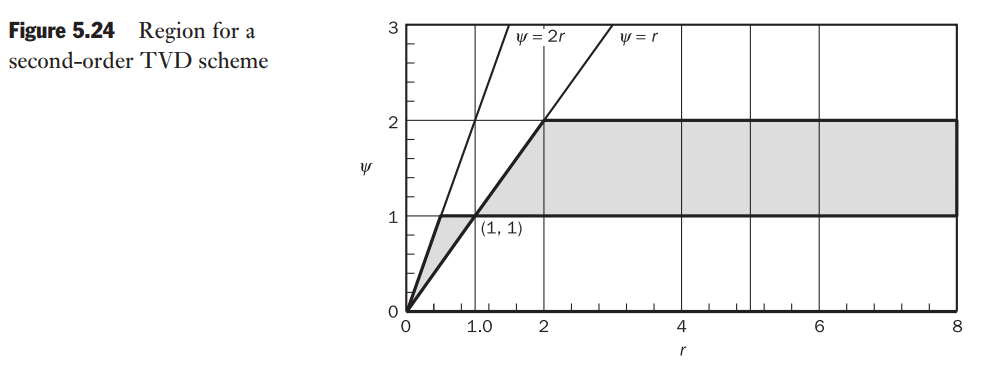CFD-FVM-08: Higher-order Differencing Schemes for Convection-diffusion Problems

Quadratic upwind differencing scheme: the QUICK scheme

For example, when
When
Combining this scheme for convective term and central differencing scheme for diffusive term, the discretization of the convection-diffusion equation for
which can be rearranged to give
In a standard form, we can write
where
For
The QUICK scheme for one-dimensional convection–diffusion problems can be summarised as follows:
with central coefficients
and
where
Assessment of the QUICK scheme
- The scheme uses consistent quadratic profiles – the cell face values of fluxes are always calculated by quadratic interpolation between two bracketing nodes and an upstream node – and is therefore conservative.
- The main coefficients (
and ) are not guaranteed to be positive and the coefficients and are negative. - Tri-diagonal matrix solution methods are not directly applicable.
Stability problems of the QUICK scheme and remedies
These formulations all involve placing troublesome negative coefficients in the source term so as to retain positive main coefficients.
The Hayase et al. (1992) QUICK scheme can be summarised as follows:
The discretisation equation takes the form
with central coefficients
and
where
General comments on the QUICK differencing scheme
- greater formal accuracy
- retains the upwind-weighted characteristics
- can lead to subtle problems: for example, they could give rise to negative turbulence kinetic energy (
) in model computations.
TVD schemes
Generalisation of upwind-biased discretisation schemes
We assume that the flow is in the positive
Upwind differencing (UD) is
These schemes can be considered as
- UD plus a correction term
- the sum of the UD convective flux
plus an additional flux contribution .
The QUICK can be rearranged in this way to give
The central differencing (CD) can be rearranged in this way to give
In a more general form
For LUD
For QUICK
Then with

Total variation and TVD schemes
For a scheme to preserve monotonicity
- it must not create local extrema
- the value of an existing local minimum must be non-decreasing and that of a local maximum must be non-increasing
In simple terms, monotonicity-preserving schemes do not create new undershoots and overshoots in the solution or accentuate existing extremes.

Consider the discrete data set shown in above figure. The total variation for this set of data is defined as
For monotonicity to be satisfied, this total variation must not increase. Monotonicity-preserving schemes have the property that the total variation of the discrete solution should diminish with time. Hence the term total variation diminishing or TVD. For transient problems,
Criteria for TVD schemes
Sweby (1984) has given necessary and sufficient conditions for a scheme to be TVD in terms of the
- If
the upper limit is , so for TVD schemes . - If
the upper limit is , so for TVD schemes .

- the UD scheme is TVD
- the LUD scheme is not TVD for
- the CD scheme is not TVD for
- the QUICK scheme is not TVD for
and
The idea of designing a TVD scheme is to introduce a modification to the above schemes so as to force the
Sweby (1984): The flux limiter function of a second-order accurate scheme should pass through the point (1, 1) in the

Sweby finally introduced the symmetry property for limiter functions:
A limiter function that satisfies the symmetry property ensures that backward- and forward-facing gradients are treated in the same fashion without the need for special coding.
Flux limiter functions
| Name | Limiter function |
Source |
|---|---|---|
| Van Leer | Van Leer (1974) | |
| Van Albada | Van Albada (1982) | |
| Min-Mod | Roe (1985) | |
| SUPERBEE | Roe (1985) | |
| Sweby | Sweby (1984) | |
| QUICK | Leonard (1988) | |
| UMIST | Lien and Leschziner (1993) |

It is relatively easy to verify that Leonard’s QUICK limiter function is the only one that is non-symmetric, whereas all the others are symmetric limiters
Implementation of TVD schemes
Consider the one-dimensional convection–diffusion equation again
The diffusion term is discretised using central differencing as before, we have
For
where
Substitution aboves into the equation gives
Rearranging gives
This can be written as
where
In a general form, we note
In a more general form, we can write the TVD neighbour coefficients as
and the TVD deferred correction source term as
where
Treatment at the boundaries
Leonard mirror node extrapolation for the left (inlet/outlet) boundary gives
Extension to two and three dimensions
TVD scheme in a two-dimensional Cartesian grid:
with central coefficient
TVD neighbour coefficients:
and the TVD deferred correction source term:
where
The extension to three dimensions is straightforward.